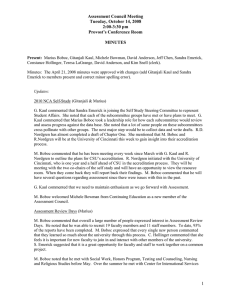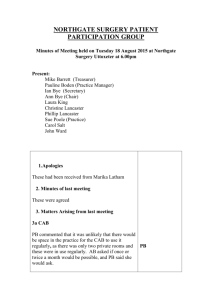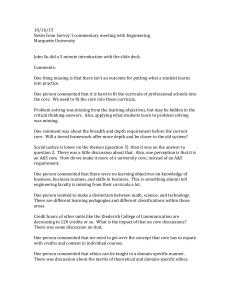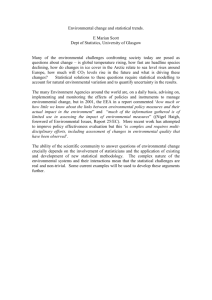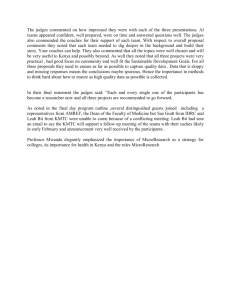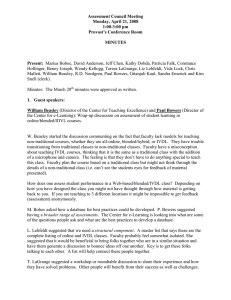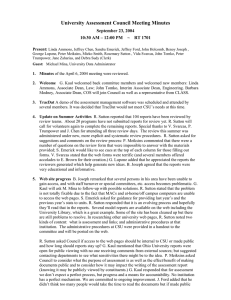Assessment Council Meeting Wednesday, February 20, 2008 10:00-12:00 noon
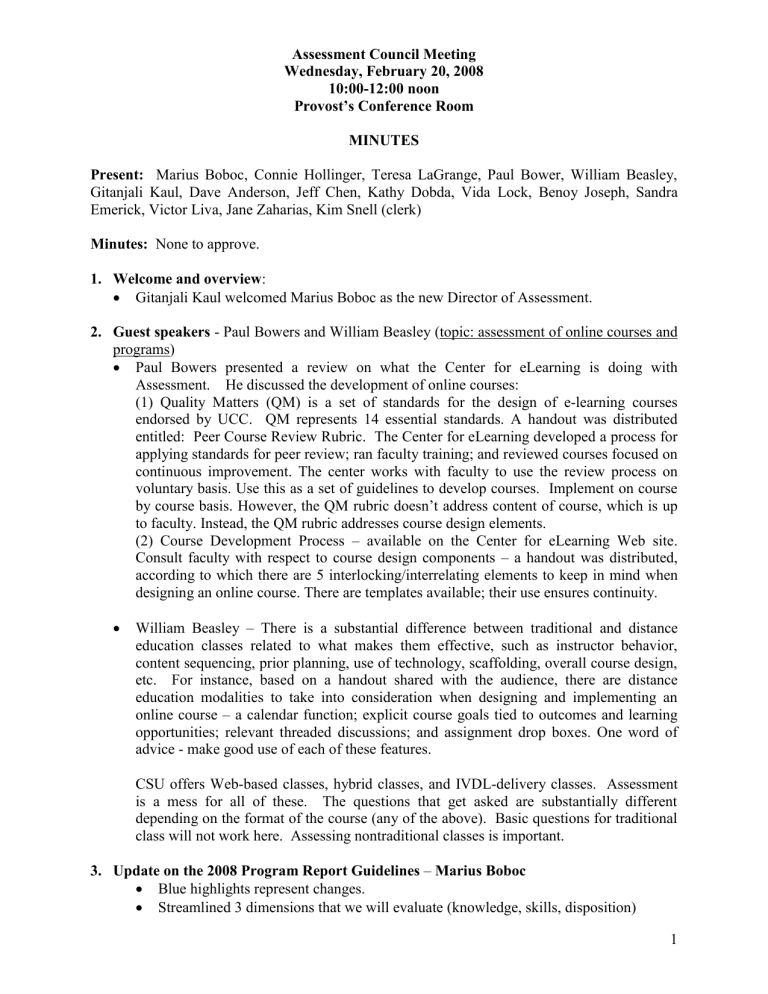
Assessment Council Meeting
Wednesday, February 20, 2008
10:00-12:00 noon
Provost’s Conference Room
MINUTES
Present: Marius Boboc, Connie Hollinger, Teresa LaGrange, Paul Bower, William Beasley,
Gitanjali Kaul, Dave Anderson, Jeff Chen, Kathy Dobda, Vida Lock, Benoy Joseph, Sandra
Emerick, Victor Liva, Jane Zaharias, Kim Snell (clerk)
Minutes: None to approve.
1.
Welcome and overview :
Gitanjali Kaul welcomed Marius Boboc as the new Director of Assessment.
2.
Guest speakers - Paul Bowers and William Beasley (topic: assessment of online courses and programs)
Paul Bowers presented a review on what the Center for eLearning is doing with
Assessment. He discussed the development of online courses:
(1) Quality Matters (QM) is a set of standards for the design of e-learning courses endorsed by UCC. QM represents 14 essential standards. A handout was distributed entitled: Peer Course Review Rubric. The Center for eLearning developed a process for applying standards for peer review; ran faculty training; and reviewed courses focused on continuous improvement. The center works with faculty to use the review process on voluntary basis. Use this as a set of guidelines to develop courses. Implement on course by course basis. However, the QM rubric doesn’t address content of course, which is up to faculty. Instead, the QM rubric addresses course design elements.
(2) Course Development Process – available on the Center for eLearning Web site.
Consult faculty with respect to course design components – a handout was distributed, according to which there are 5 interlocking/interrelating elements to keep in mind when designing an online course. There are templates available; their use ensures continuity.
William Beasley – There is a substantial difference between traditional and distance education classes related to what makes them effective, such as instructor behavior, content sequencing, prior planning, use of technology, scaffolding, overall course design, etc. For instance, based on a handout shared with the audience, there are distance education modalities to take into consideration when designing and implementing an online course – a calendar function; explicit course goals tied to outcomes and learning opportunities; relevant threaded discussions; and assignment drop boxes. One word of advice - make good use of each of these features.
CSU offers Web-based classes, hybrid classes, and IVDL-delivery classes. Assessment is a mess for all of these. The questions that get asked are substantially different depending on the format of the course (any of the above). Basic questions for traditional class will not work here. Assessing nontraditional classes is important.
3.
Update on the 2008 Program Report Guidelines – Marius Boboc
Blue highlights represent changes.
Streamlined 3 dimensions that we will evaluate (knowledge, skills, disposition)
1
Made sure that report form is clear that we are investigating student learning not instructor evaluation.
Column 2 was changed to “What does it mean?” – more user friendly.
Made distinction program/unit and used it consistently in the whole form.
D. Anderson commented on the – Introductory requirement – must itemize things that we want to see. It may be helpful for the submitter to answer comments in each section. Where did you see change? What did you implement? Some folks choose to do a narrative. Be clear what ever we decide. B. Joseph thought the report should be more structured. Look at suggestions made last year. Did they take actions? G.
Kaul wondered if it is worth it to add length to the report. D. Anderson was concerned about asking for more and more. It must be important if it is to be added.
In principle he supports some kind of mechanism. Does each section address changes instead of one general question? M. Boboc stated that the Program Coordinators expressed doubts about misrepresentation. Contextualize program. B. Joseph though that context is good idea but should be optional. M. Boboc felt the focus should be on change in specific sections. T. LaGrange commented that in CLASS this was still a very awkward process. She felt that it would be better to stay away from adding new sections. There is a real sense of uncertainty on what they are supposed to do.
Limit what is new or additional and possibly consider just adding additional comments.
M. Boboc introduced the idea of Diagnostic review sheets . Get in touch with units to compare previous years reports. He asked if this would help programs to have a comparison review over the last 2 years.
The discussion centered on supporting this new tool. There was concern about the amount of work involved but M. Boboc felt he was prepared to do the work and felt it useful for the programs/units undergoing review. T. LaGrange commented that the preliminary analysis would give them an idea of what they need to focus on. M.
Boboc would have summer review sessions with each program/unit.
M. Boboc asked for a deadline in receiving input on the Guidelines from the committee members. Everyone agreed on a one week deadline of February 26,
2008 .
J. Zaharius suggested allowing for a supplementary narrative for responding to questions that don’t get table. B. Joseph noted that the executive summary should be limited to half a page. M. Boboc commented that there is no need to replicate any data for colleges currently going through the assessment process. G. Kaul noted that we don’t want a report that says we have already done these items. She also suggested adding a list of accredited programs to the template.
M. Boboc commented that there should be a section related to curriculum alignment.
He asked if a section like that would help programs in aligning outcomes and objectives. Review form for integration. There is no section like that in the guidelines. Every program should think of alignment. J. Zaharius commented that this is a judgment activity. When you review a program it should be apparent that there is integration. It should be noticeable in the tables. K. Dobda suggested that follow-up actions should be integration. She noted that for those of us who have to
2
assess a non-instructional unit that it is difficult to figure out how to have findings when these programs do not have graduates or specific testing. J. Zaharius commented that we are providing services for these students and to note the degree in which you are providing these specific services. S. Emerick added that you should assess what is measurable and develop your own set of processes. J. Chen commented that M. Boboc should be put as a resource person on the memo.
Update on the review form for summer reviewers
– Marius Boboc
Findings, review, actions. Data analysis in orange. Follow-up actions are based on what you found and then what did you do with those findings.
S. Emerick commented that this is to be used as an internal document. V. Liva suggested reading through the document to soften any language. He asked if there had ever been a case when the program disagreed with the review team. M. Boboc replied that this has not happened before. J. Zaharius commented that there is no place on the form that addresses what the programs have done with the findings of the previous year. S. Emerick commented that question number one has never been helpful to her and it might be more helpful to focus on changes made from last year.
M. Boboc will work on changing question one.
Were limitations and recommendations addressed from last years report?
T. LaGrange noted that the word optional should be taken out of the report. M.
Boboc will work individually with departments to address questions and concerns.
The goal is to make assessment a known entity and help the programs. Guidelines will be sent to everyone.
4.
Introductory Memo (to be sent out by Marius to Deans, Assoc. Deans, and Program
Coordinators/Directors)
S. Emerick commented that Student Services is no longer correct and may need to update program list. M. Boboc will talk to Rosemary Sutton in Undergraduate
Studies to clarify the list of individuals responsible for submitting the assessment reports. S. Emerick suggested forwarding reports to designated Deans. G. Kaul commented that there is a difference in being copied and actually on the list of intended recipients. She felt that this would give the college leverage. J. Zaharius assigns a date that the Chairs will have to have all stuff to me by May 15. This assures her that she is getting all materials related to program review. T. LaGrange noted that the bolded sentence should be changed. Send to appropriate person in unit by designated time set by department.
G. Kaul will work with M. Boboc to think of other units such as the Library,
Graduate Studies, Registrar, Financial Aid, Orientation & Campus 411. These units should be clustered together. G. Kaul noted that Orientation is under Mike Droney.
5.
Research Practices Survey - Kathy Dobda
Liz Lehfeldt identified 5 classes where this survey could be administered. Have comparison data with upper class. Just identified Gen. Ed. course. Looking for volunteer classes. G. Kaul and J. Chen can pull out 300-400 level courses. J.
Zaharius suggested capstone classes. They could allow seminar time. J. Chen will work with Kathy to identify classes.
3
6.
Update on the Student Assessment Web site (moved to next meeting)
7.
Identifying student learning assessment-related needs (Marius to e-mail AC members asking for ideas in preparation for the March meeting)
8.
(Re)Capturing Assessment Momentum (moved to next meeting)
9.
Categorical analysis of previous program/unit report reviews (diagnostic review sheet – shared with the AC members who endorsed it as presented)
10.
Understanding CSU (brainstorm ideas related to the next issue of our newsletter – Marius to e-mail AC members to think of topics for discussion the next time we meet in March)
11.
CLA Update – Gitanjali Kaul
Active Gen. Ed. Assessment. We do have a Gen Ed director. CLA is Collegiate
Learning Assessment. Standardized test of Gen Ed abilities. Voluntary Student
Assessment has become mandatory. All institutions will administer one of 3 tests -
CAPPA, MAPP, CLA.
CLA: Administered the 2-hour test; very difficult to take or interest students in taking it. 2009 – readministered test.
Last results: Below national norm. Actual success and predicted success. Actually above normal outcomes. Value added piece as something we want to highlight.
Have own faculty pick up gen ed courses – clusters. Internal way of assessing skills.
Liz, Marius and Gitanjali active in Assessment Council. K. Dobda – UCC. No way of tracking individual students in taking all 6 skill areas. What if someone wants to change skill area they want to work on? G. Kaul added that time will be devoted to this program in upcoming meetings. Library was not a concern. T. LaGrange suggested that changes will have to be made to Quantitative Literacy.
Next Meeting : Thursday, March 20, 2008
10:00 – 12:00 noon
Provost’s Conference Room
4
